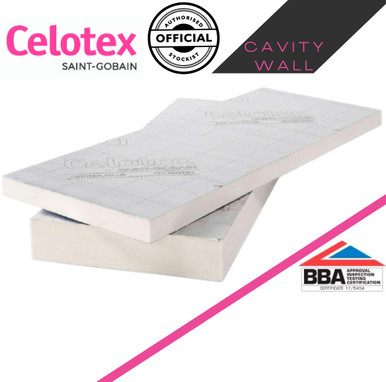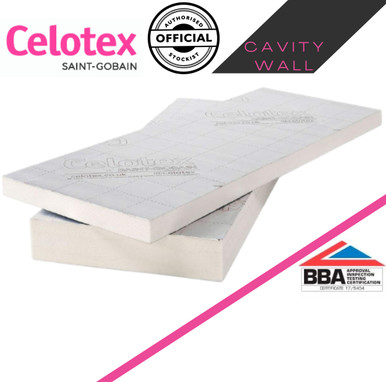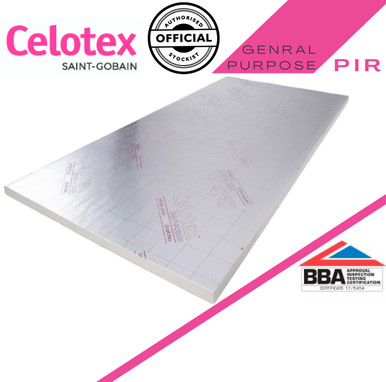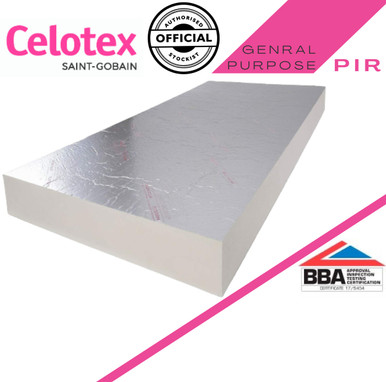Introduction
At Insulation Superstore, we understand how important it is to choose the correct insulation for your home in order to keep it warm, save money, and reduce your environmental impact. But, with so many various types of insulation available, how can you know which is best for you?
Celotex has been manufacturing and supplying PIR insulation boards for over 90 years, making them market leaders in the field. Which Celotex insulating board, however, is best suited to your project? We've put together an easy-to-understand reference on the various Celotex PIR boards available to help you decide on the best Celotex insulation boards for your project.
Celotex GA4000 insulation boards
Celotex GA4000 Uses
The Celotex GA4000 series consists of general-purpose PIR boards with thicknesses ranging from 50mm to 100mm. GA4000 is a highly adaptable insulation board that may be utilized in a wide range of applications. GA4000 insulation boards can be utilized in ground floors that are solid concrete, suspended wood, or block and beam, as well as ground floors that have underfloor heating. GA4000 insulation boards can also be utilized in pitched roofs, flat roofs, timber and steel framed walls, and a variety of other retrofitting and renovation projects.
Celotex GA4000 Specifications
Celotex GA4000 insulation boards are made of polyisocyanurate and contain low emissivity foil facings to aid in heat transfer reduction.
The resistance to heat flow is denoted by the R-value; the greater the R-value, the more insulating the product.
Celotex TB4000 insulation boards
Celotex TB4000 Uses
Celotex TB4000 insulation boards are general purpose PIR boards that can be utilized in a variety of applications, comparable to Celotex GA4000 insulation boards. Celotex TB4000 insulation boards can be used in a variety of applications, including floors, solid walls, timber and steel frame constructions, and more. Because of the thin properties of the TB4000 series, it is particularly well suited to combating localised heat losses and thermal bridging.
Celotex TB4000 Specifications
TB4000 insulation boards are polyisocyanurate boards with low emissivity facings, similar to GA4000 insulation boards. However, as illustrated below, TB4000 insulation boards are substantially thinner than the GA4000 series.
The resistance to heat flow is denoted by the R-value; the greater the R-value, the more insulating the product.
Celotex XR4000 insulation boards
Celotex XR4000 Uses
Celotex XR4000 Specifications
The Celotex XR4000 insulation boards are high performance, thin insulation boards that provide the highest insulating values in the Celotex insulation board line while being relatively thin. For exact R- values, thicknesses, and sizes, see the table below.
The resistance to heat flow is denoted by the R-value; the greater the R-value, the more insulating the product.
Celotex CW4000 insulation boards
Celotex CW4000 Uses
Celotex CW4000 Specifications
The CW4000 PIR board range contains foil facings to minimize potential heat transmission within hollow wall spaces and was developed for a specific usage within cavity wall spaces. The CW4000 insulation boards are available in shorter lengths and widths to reduce installation time within cavity walls.
The resistance to heat flow is denoted by the R-value; the greater the R-value, the more insulating the product.
Celotex Thickness Chart
Are you looking for a guide to the different thicknesses of Celotex insulation boards?
There are numerous types and thicknesses of insulation boards available on the market today. Manufacturers don't always make it simple to understand the differences between their products and which one will work best for your specific application.
This guide deconstructs the most common Celotex Insulation board thicknesses so you can make an informed decision about which board is best for you.
CELOTEX INSULATION BOARDS COME IN WHAT THICKNESS?
Celotex insulation boards are available in a variety of thicknesses, depending on the board.
For the sake of brevity, they are all identified by a six-digit product code. The first four digits are simply for product identification, while the last two digits indicate the board's thickness in millimeters.
A Celotex GA4000 board with the code GA4050, for example, would be 50mm thick.
The five most common Celotex insulation product ranges, as well as their corresponding product codes and thicknesses, are discussed below.
The models are Celotex GA4000, TB4000, XR4000, CW4000, and PL400.
Let's start with the multipurpose insulation board ranges: TB4000, GA4000, and XR4000.
THICKNESS OF CELOTEX GENERAL PURPOSE PIR INSULATION BOARD
Celotex TB4000
TB4000 stands for "thermal bridging." These are thinner boards that are commonly used to overcome cold spots and thermal bridging in timber frame and roof insulation.
Celotex TB4000 comes in thicknesses ranging from 20mm to 40mm.
Celotex GA4000
GA4000 stands for "general application boards." These are the most common Celotex board sizes because they are suitable for a wide range of applications.
Celotex GA4000 comes in thicknesses ranging from 50mm to 100mm.
Celotex XR4000
Celotex XR4000 is the company's thickest insulation. They are used when a thicker board is required to meet the required u values.
Celotex XR4000 comes in thicknesses ranging from 110mm to 200mm.
Apart from the general thermal insulation boards mentioned above, there are two other popular Celotex products: Celotex PL4000 and Celotex CW4000.
CELOTEX INSULATED PLASTERBOARD THICKNESS
Celotex PL4000
Celotex PL4000 is a high performance insulated plasterboard product that is made up of a single layer of plasterboard bonded to PIR insulation board. This results in a very cost-effective insulation and plasterboard product that saves time when plastering and insulating walls. It is especially popular in existing buildings because it can save money over other options.
The PL4000 insulation board, like all Celotex insulation boards, has a low global warming potential, no ozone depletion potential, and low thermal conductivity.
Celotex PL4000 comes in thicknesses ranging from 25mm to 65mm for the insulation board and an additional 12.5mm for the plasterboard. For a total thickness of 37.5mm to 77.5mm
CELOTEX CAVITY WALL THICKNESS
Celotex CW4000
Celotex CW4000 is a high performance cavity wall insulation board from Celotex. They are conveniently sized boards that are specifically designed to fit in between cavity wall ties in masonry walls' cavities. The foil facings, like the rest of the Celotex range, are low emissivity foil facings that provide better insulation and lower u values.
Celotex CW4000 comes in thicknesses ranging from 40mm to 100mm.
CELOTEX INSULATION BOARD PRODUCT CODES AND THICKNESS EXPLAINED
Celotex's insulation boards are labeled with product codes that indicate their thickness. The different product codes all relate to the thickness of the board, as you'll see below. So, if you're looking for a specific board thickness, simply look for the product code that corresponds to it.
Celotex TB4000 thermal bridging board
- TB4020: 20mm
- TB4025: 25mm
- TB4030: 30mm
- TB4040: 40mm
Celotex GA4000 Insulation
- GA4050: 50mm
- GA4060: 60mm
- GA4070: 70mm
- GA4075: 75mm
- GA4080: 80mm
- GA4090: 90mm
- GA4100: 100mm
Celotex XR4000 Insulation
- XR4110: 110mm
- XR4120: 120mm
- XR4130: 130mm
- XR4140: 140mm
- XR4150: 150mm
- XR4165: 165mm
- XR4200: 200mm
Celotex PL4000 Insulated Plasterboard
- PL4025: 25mm (37.5mm including plasterboard)
- PL4040: 40mm (52.5mm including plasterboard)
- PL4050: 50mm (62.5mm including plasterboard)
- PL4060: 60mm (72.5mm including plasterboard)
- PL4065: 65mm (77.5mm including plasterboard)
Celotex CW4000 Cavity Wall Insulation
- CW4040: 40mm
- CW4050: 50mm
- CW4060: 60mm
- CW4075: 75mm
- CW4085: 85mm
- CW4100 100mm.
What's the Difference Between Celotex TB4000, GA4000, XR4000?
The Celotex website states:
"TB4000 is a simple-to-install polyisocyanurate (PIR) insulation board with excellent thermal performance, a low emissivity foil facing, and a low global warming impact. It can be used for floor, wall, and roof applications."
Whereas...
"Celotex GA4000 is an easy-to-install polyisocyanurate (PIR) insulation board with excellent thermal performance and a low emissivity foil facing, suitable for roof, wall, and floor applications."
And...
"Celotex XR4000 is an easy-to-install polyisocyanurate (PIR) insulation board with excellent thermal performance, low emissivity foil facings, and a low global warming impact, suitable for roof, wall, and floor applications."
In other words, they are all the same item.
According to the bre green guide, they all have foil facings, have zero ozone depletion potential, and have a low global warming potential.
The only distinction between the three Celotex products is the thicknesses available. That's all!
Some believe Celotex should change their marketing and simplify the unnecessary use of different product codes for what is essentially the same product, but once explained, it's simple to understand.
FREQUENTLY ASKED QUESTIONS
- What is the thinnest Celotex?Celotex's thinnest board is TB4000, which has a minimum thickness of 20mm. It is intended for use in overcoming thermal bridging and eliminating cold spots.
- What is the thickest Celotex?
Celotex XR4000 is the thickest Celotex board, with thicknesses ranging from 110mm to 200mm. It is popular in flat roofs and is used as a general application board.
- What is the difference between Celotex GA4000, and XR4000?
In a nutshell, not much! The GA4000 is simply a board that comes in smaller thicknesses, whereas the XR4000 comes in larger thicknesses. They are both intended to be general-purpose application boards that can be used for a variety of purposes.
- What thickness of Celotex do I need?
The answer is determined by a number of factors, including the specific application, budget, and desired U value. However, as a general rule, you should always select the thickness of the board that provides the best insulation for your needs while still meeting any Building Regulations requirements. It is always better to choose a thicker board because it will provide better insulation, but keep in mind that depending on the application, you may also need to factor in enough space to allow for an air gap, and the thicker the board, the more expensive it will be.















